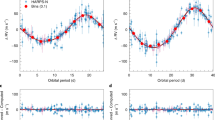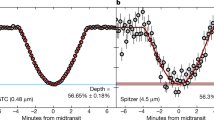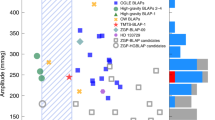Abstract
Schlosser and Bergmann1 recently presented evidence that in medieval times Sirius was a bright red star, rather than the present bluish-white star, from which they have suggested that Sirius B is a recently born white dwarf. However, their model poses severe evolutionary problems. We present the results of our attempts to detect possible planetary nebula ejecta toward Sirius, using data obtained by the International Ultraviolet Explorer (IUE) satellite. Based upon these results and in the light of recent advances in understanding white-dwarf evolution, we propose that Sirius B underwent a recent thermonuclear runaway event, triggered by a diffusion-induced CN reaction, to explain the historical behaviour of this star.
This is a preview of subscription content, access via your institution
Access options
Subscribe to this journal
Receive 51 print issues and online access
$199.00 per year
only $3.90 per issue
Buy this article
- Purchase on Springer Link
- Instant access to full article PDF
Prices may be subject to local taxes which are calculated during checkout
Similar content being viewed by others
References
Schlosser, W. & Bergmann, W. Nature 318, 45–46 (1985).
Böhm-Vitense, E., Dettmann, T. & Kapranidis, S. Astrophys. J. 232, L189–L192 (1979).
Bruhweiler, F. & Sion, E. Astrophys. J. 304, L74 (1986).
Bruhweiler, F. & Kondo, Y. Astrophys. J. 259, 232–243 (1982).
McClintock, W., Henry, R., Linsky, J. L. & Moos, H. W. Astrophys. J. 225, 465–481 (1978).
Kondo, Y., Talent, D., Barker, E., Dufour, R. & Modisette, J. Astrophys. J. 220, L97–L102 (1977).
Aumann, H. H. Bull. Am. astr. Soc. 16, 483 (1984).
Aumann, H. H. et al. Astrophys. J. 278, L23–L27 (1984).
Smith, B. & Terrile, R. Science 226, 1421–1424 (1984).
Kondo, Y. & Bruhweiler, F. Astrophys. J. 291, L1–L5 (1985).
Michaud, G., Fontaine, G. & Charland, Y. Astrophys. J. 280, 247–254 (1984).
Michaud, G. & Fontaine, G. Astrophys. J. 283, 787–793 (1984).
Iben, I. & Tutukov, M. Astrophys. J. 282, 615–630 (1984).
Sienkiewicz, R. Astr. Astrophys. 85, 295–301 (1980).
Papaloizou, J., Pringle, J. & MacDonald, J. Mon. Not. R. astr. Soc. 198, 215–220 (1982).
Iben, I. Astrophys. J. 259, 244–266 (1982).
Sion, E. & Starrfield, S. Astrophys. J. 303, 130–135 (1986).
Author information
Authors and Affiliations
Rights and permissions
About this article
Cite this article
Bruhweiler, F., Kondo, Y. & Sion, E. The historical record for Sirius: evidence for a white-dwarf thermonuclear runaway?. Nature 324, 235–237 (1986). https://doi.org/10.1038/324235a0
Received:
Accepted:
Issue Date:
DOI: https://doi.org/10.1038/324235a0
This article is cited by
-
Did Sirius change colour?
Nature (1991)
-
Sirius and the colour enigma
Nature (1990)
-
Concluding remarks
Astrophysics and Space Science (1988)
Comments
By submitting a comment you agree to abide by our Terms and Community Guidelines. If you find something abusive or that does not comply with our terms or guidelines please flag it as inappropriate.



